In the pitch-black realms of our planet, where light never penetrates, extraordinary life forms have evolved remarkable adaptations that enable them to not just survive, but flourish in complete darkness. From the deepest ocean trenches to lightless cave systems and subterranean environments, these species have developed fascinating alternatives to vision-based living. Their evolutionary journey has produced unique sensory systems, metabolic processes, and physical characteristics that allow them to navigate, hunt, reproduce, and thrive in a world without light. This exploration of 13 remarkable species reveals nature’s ingenious solutions to one of life’s most fundamental challenges: how to prosper when permanently deprived of light.
13. Olm (Proteus anguinus) – The Cave Dragon

The olm, sometimes called the “human fish” for its pale, flesh-colored skin, is a remarkable amphibian that has evolved specifically for cave life in the subterranean waters of the Dinaric Alps in Central and Southeastern Europe. These slender, salamander-like creatures can reach lengths of up to 12 inches and possess several extraordinary adaptations for their lightless habitat. Having lived in darkness for millions of years, olms have essentially lost their eyes during evolution – they develop eyes as embryos, but these regress and are eventually covered by skin as they mature. Despite their blindness, olms possess an acute sense of hearing and can detect both electric and magnetic fields, allowing them to navigate and hunt effectively. Perhaps most remarkable is their extraordinary lifespan of up to 100 years and their ability to survive without food for up to a decade by reducing their metabolic rate and utilizing stored reserves.
12. Cave Crayfish (Orconectes australis) – The Colorless Crustacean
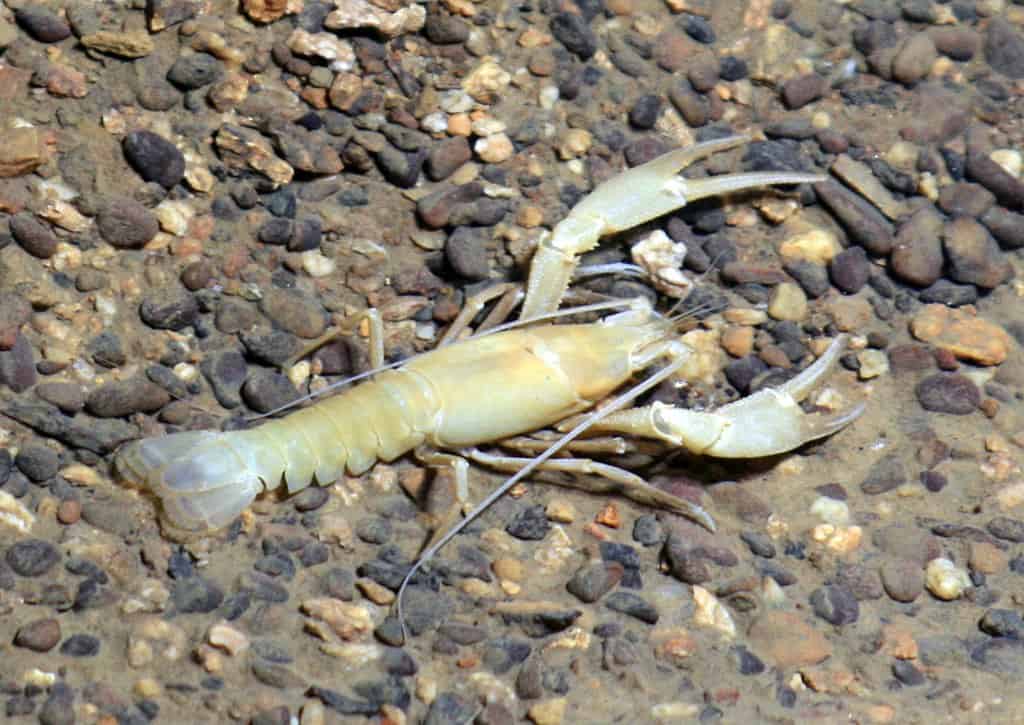
Cave crayfish represent one of nature’s most striking examples of adaptation to perpetual darkness. These pale, eyeless crustaceans inhabit subterranean waters throughout cave systems in North America and elsewhere. Unlike their surface-dwelling relatives, cave crayfish have undergone dramatic physical changes through evolution. Their most notable features include the complete absence of pigmentation, resulting in their ghostly white appearance, and the reduction or complete loss of eyes, which serve no purpose in their lightless environment. To compensate for their lack of vision, these remarkable creatures have developed extraordinarily elongated antennae and sensory hairs that detect subtle water movements, chemical signatures, and vibrations. This enhanced tactile sense allows them to locate food, avoid predators, and find mates in complete darkness. Their metabolism has also slowed significantly, enabling them to survive in environments where food resources are often scarce and unpredictable.
11. Mexican Blind Cavefish (Astyanax mexicanus) – The Evolutionary Marvel

The Mexican blind cavefish represents one of science’s most fascinating case studies in evolutionary adaptation. What makes this species particularly valuable to researchers is that both surface-dwelling (eyed) and cave-dwelling (eyeless) populations exist, allowing scientists to study the genetic mechanisms behind adaptation to darkness. These fish begin developing eyes as embryos, but the eyes later degenerate and are covered by skin as they mature in cave populations. To compensate for their lack of vision, blind cavefish have evolved an enhanced lateral line system – rows of pressure-sensitive cells that detect changes in water pressure and movement. They’ve also developed larger jaws, more numerous taste buds, and can detect changes in water pressure from nearby objects through a phenomenon known as hydrodynamic imaging. Remarkably, studies have shown these fish actually sleep significantly less than their surface-dwelling relatives, likely an adaptation to maximize feeding opportunities in their food-scarce environment.
10. Giant Squid (Architeuthis dux) – Abyssal Predator

The legendary giant squid inhabits the ocean’s midnight zone, where sunlight never penetrates, at depths between 300 and 1,000 meters. These elusive cephalopods are true giants, reaching lengths of up to 13 meters (43 feet) including their tentacles, making them among the largest invertebrates on Earth. Unlike many deep-sea creatures that have lost their visual capabilities, giant squid possess the largest eyes in the animal kingdom—up to 10 inches in diameter. These massive eyes collect whatever faint light might exist, including bioluminescence from other organisms. Their eyes contain a high concentration of rhodopsin, a light-sensitive pigment that enhances vision in near-darkness. Additionally, giant squid have developed a sophisticated nervous system and can rapidly change their skin’s chromatophores to produce patterns and flashes of bioluminescence, which they use for communication and possibly to attract prey. Their hunting strategy relies on ambushing prey using their two long feeding tentacles, which can shoot out with remarkable speed to grab passing fish and other deep-sea creatures.
9. Hydrothermal Vent Tubeworms (Riftia pachyptila) – Chemical Energy Harvesters
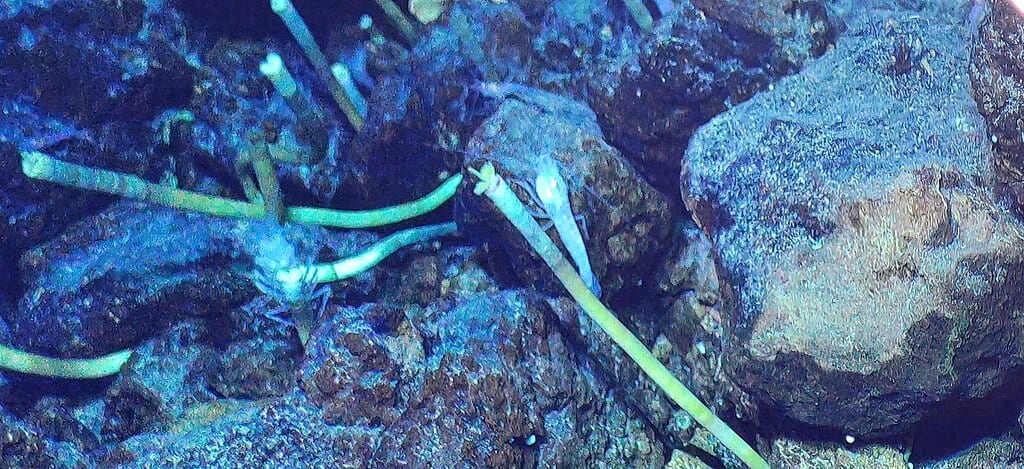
Perhaps one of the most astonishing examples of adaptation to darkness comes from hydrothermal vent tubeworms, which not only thrive without light but have also revolutionized our understanding of life’s possibilities. These remarkable invertebrates grow up to 2 meters tall near deep-sea hydrothermal vents, where superheated, mineral-rich water erupts from cracks in the ocean floor. What makes these creatures truly extraordinary is their complete independence from sunlight-based food chains. Adult tubeworms lack both mouths and digestive systems, instead housing specialized bacteria within their tissue that convert toxic hydrogen sulfide from the vents into usable energy through chemosynthesis. The worm’s bright red plume, which extends from its protective tube, contains hemoglobin that absorbs both oxygen and hydrogen sulfide from the water, which is then transported to the bacteria. This symbiotic relationship represents one of evolution’s most impressive solutions for surviving in an environment completely devoid of sunlight, demonstrating that life can exist based entirely on chemical energy rather than light energy.
8. Yeti Crab (Kiwa hirsuta) – The Hairy Deep-Sea Farmer
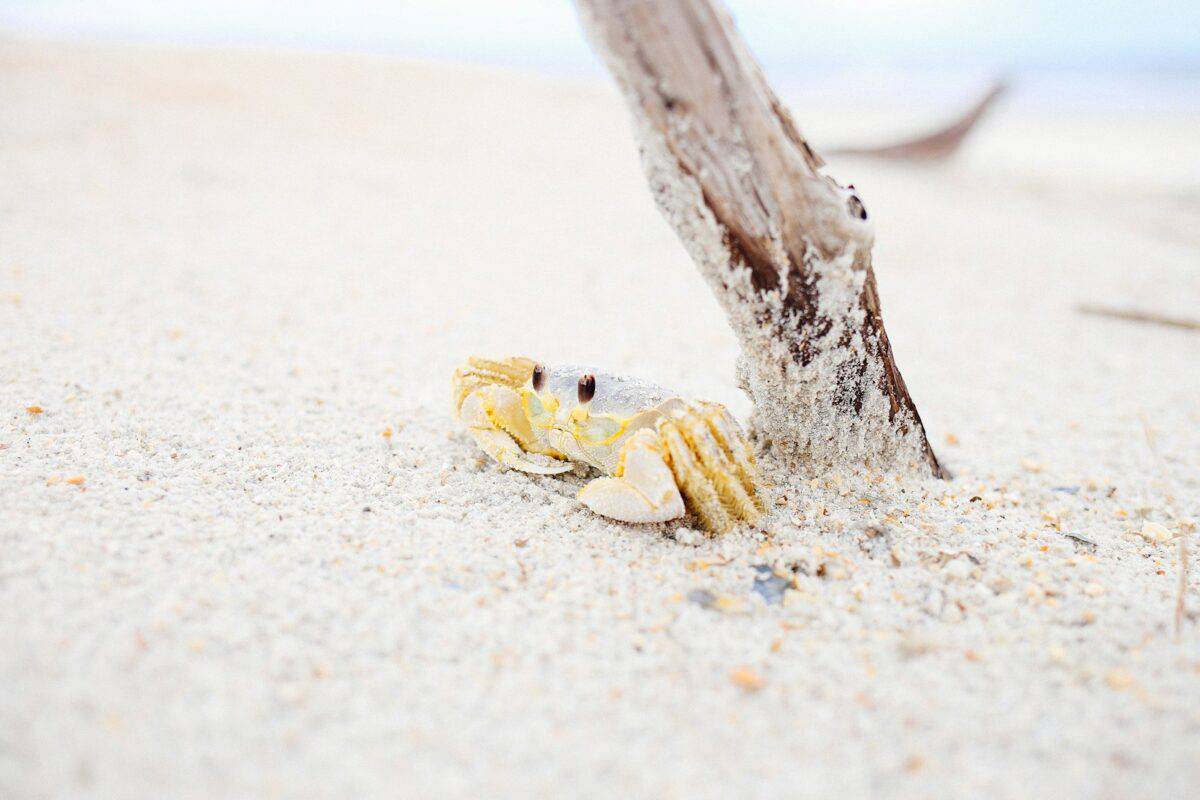
The Yeti crab, discovered only in 2005, represents one of the most peculiar adaptations to lightless deep-sea environments. Named for its distinctive cream-colored, hair-like setae covering its appendages, this unusual crustacean lives near hydrothermal vents in the South Pacific Ocean at depths of around 2,200 meters. What makes the Yeti crab’s adaptation particularly fascinating is how it has developed a form of “farming” in complete darkness. The hair-like structures on its arms aren’t just for show—they cultivate filamentous bacteria that feed on chemicals from the hydrothermal vents. The crab then uses specialized appendages similar to combs to harvest these bacteria as their primary food source. This symbiotic relationship effectively allows the Yeti crab to “farm” its own food in an environment where traditional food sources are scarce. Additionally, these crabs have reduced eyes with limited function, as vision provides little advantage in their pitch-black habitat, and instead rely on chemical and tactile senses to navigate their environment and detect potential mates and threats.
7. Blind Cave Tetra (Astyanax jordani) – The Eye Sacrificer

The blind cave tetra offers a remarkable example of evolutionary trade-offs in adapting to darkness. These small freshwater fish, found in underground caves throughout Mexico, have not only lost their eyes but have redirected the energy that would have been used for vision toward enhancing other senses. Research has shown that the genetic mutations that caused eye loss simultaneously triggered an increase in the number and sensitivity of taste buds and pressure-sensing organs. Their lateral line system—a series of sensory organs that detect water movement and pressure gradients—has become extraordinarily developed, allowing them to create detailed “mental maps” of their surroundings through what scientists call hydrodynamic imaging. Additionally, blind cave tetras have evolved to store more fat and have a slower metabolism than their surface-dwelling relatives, crucial adaptations for environments where food availability is unpredictable. Perhaps most fascinating is recent research suggesting that eye loss may have directly provided evolutionary advantages beyond energy conservation—the same genetic changes that eliminate eyes appear to enhance jaw structure and feeding efficiency, demonstrating how organisms can repurpose resources when adapting to extreme environments.
6. Lava Cave Pseudoscorpions (Pseudogarypus hypogeus) – Miniature Darkness Specialists

Among the most specialized cave-dwelling creatures are lava cave pseudoscorpions, tiny arachnids that have evolved specifically for life in total darkness. Despite resembling small scorpions, they lack the characteristic tail and stinger, typically measuring only 2-8mm in length. These remarkable creatures inhabit the narrow cracks and spaces within lava tube cave systems, particularly in the western United States. Having evolved in isolation for millions of years, they display classic adaptations to perpetual darkness: they are completely eyeless, possess elongated appendages with enhanced sensory capabilities, and have lost all body pigmentation, resulting in their translucent, ghostly appearance. Their pedipalps—claw-like appendages—have become highly specialized with chemosensory hairs that can detect minute prey movements and chemical signatures in the air. Their extraordinarily slow metabolism allows them to survive long periods without food, sometimes up to several months, a crucial adaptation for environments where prey encounters may be extremely rare. What makes these pseudoscorpions particularly fascinating to scientists is their highly restricted range—some species exist only in a single cave system, having evolved in complete isolation and representing a unique evolutionary lineage.
5. Champagne Worms (Hesiocaeca methanicola) – Methane Ice Dwellers
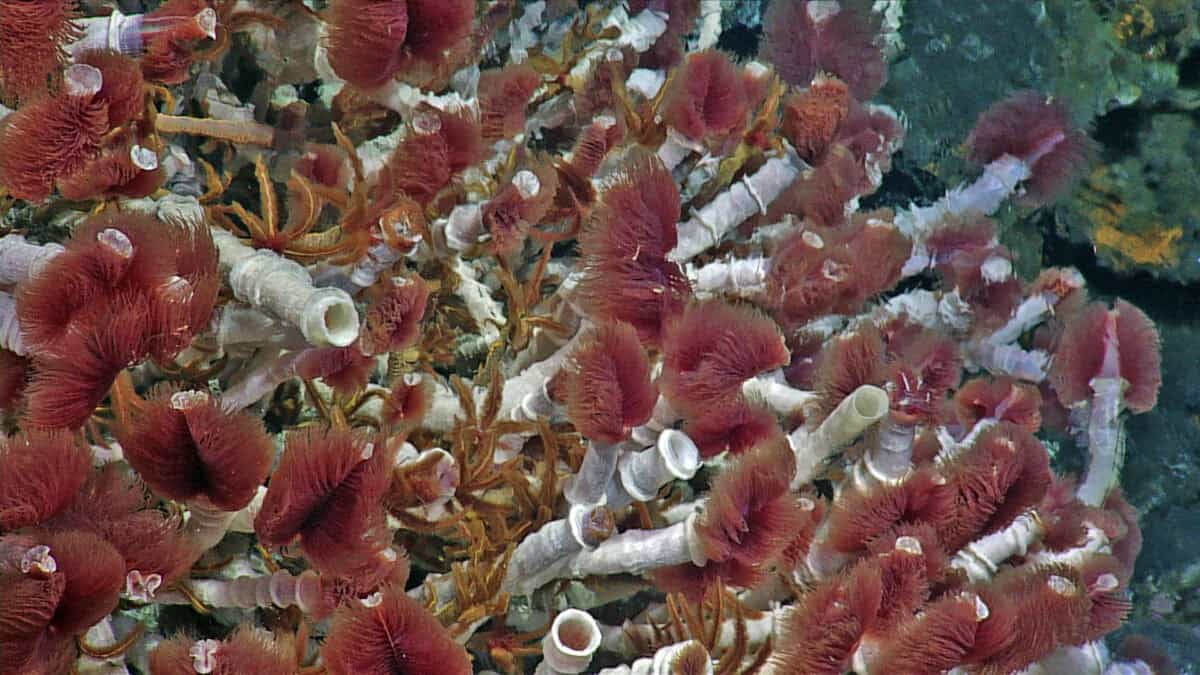
In one of Earth’s most extreme habitats, methane ice mounds on the deep ocean floor, lives the remarkable champagne worm (Hesiocaeca methanicola), discovered only in 1997. These polychaete worms have developed the extraordinary ability to colonize solid methane hydrate deposits—essentially methane gas trapped in ice—at depths of approximately 1,800 feet in the Gulf of Mexico. Their nickname comes from the bubbling effect created when their movements release methane from the ice, resembling champagne. What makes these worms truly remarkable is their specialized metabolism that allows them to derive nutrients from methane-oxidizing bacteria that grow on the hydrate surfaces. They possess no eyes, as they would serve no purpose in their permanently dark habitat, and instead rely entirely on chemical and tactile senses to navigate their environment. Their body structure has evolved specialized respiratory surfaces that can function under the extreme pressure conditions of the deep sea. Scientists believe these worms may represent one of the most specialized chemical-dependent ecosystems on the planet, demonstrating life’s incredible capacity to adapt to environments completely devoid of both light and conventional food sources.
4. Kauai Cave Wolf Spider (Adelocosa anops) – The Sightless Hunter

The Kauai Cave Wolf Spider represents one of the most remarkable evolutionary adaptations to subterranean darkness and highlights the fragility of such specialized species. Endemic solely to a handful of caves on the Hawaiian island of Kauai, this critically endangered arachnid has developed extraordinary adaptations for hunting in perpetual darkness. Unlike most spiders that build webs, this wolf spider actively hunts its prey, despite being completely eyeless. Where its eight eyes would normally be, only tiny indentations remain after millions of years of evolution in darkness. To compensate for its blindness, the spider has developed extraordinarily sensitive hairs on its legs and body that can detect the slightest air movements and vibrations, effectively creating a three-dimensional sensory picture of its surroundings. Its primary prey, the equally rare Kauai cave amphipod, is tracked through chemical signals and minute vibrations. Most fascinating is that, unlike most wolf spiders that release their young after hatching, the female Kauai cave wolf spider carries her spiderlings on her back until they’re capable of hunting independently—an adaptation that enhances offspring survival in an environment where finding mates and prey is exceptionally challenging.
3. Movile Cave Bacteria – Primordial Darkness Adapters
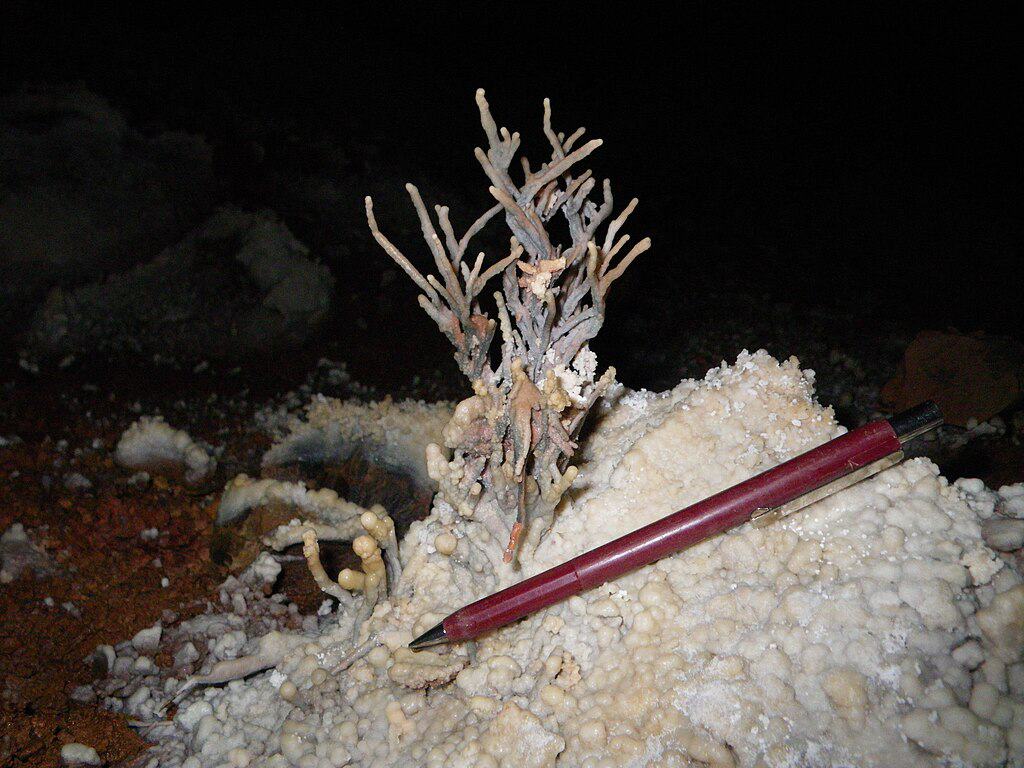
In Romania’s Movile Cave, sealed off from the outside world for 5.5 million years, exists one of Earth’s most extraordinary ecosystems founded entirely on chemosynthetic bacteria that thrive in absolute darkness. These specialized microorganisms have evolved to derive energy not from sunlight through photosynthesis, but from the chemical oxidation of hydrogen sulfide and methane that naturally permeate the cave atmosphere. What makes these bacteria truly remarkable is that they form the base of a completely self-contained food web, supporting at least 48 species found nowhere else on Earth. The cave’s atmosphere contains extremely low oxygen levels (10% compared to 21% above ground) and high concentrations of hydrogen sulfide and carbon dioxide that would be toxic to most surface organisms. The bacteria have adapted specialized metabolic pathways that not only tolerate these conditions but thrive in them, forming thick mats on the cave water’s surface and walls. Some bacterial species have developed unique mechanisms to fix carbon in darkness, effectively performing photosynthesis without light. These microorganisms represent living examples of what early Earth conditions might have supported before the evolution of photosynthesis, offering scientists valuable insights into how life might exist on other planets where sunlight is absent or minimal.
2. Deep Sea Anglerfish (Melanocetus johnsonii) – Bioluminescent Lurer

Perhaps the most iconically adapted creature to deep-sea darkness is the female anglerfish, with its ghostly appearance and bioluminescent lure that dangles from a modified dorsal fin spine above its enormous, tooth-filled mouth. Living at depths between 1,000 and 4,000 meters where sunlight never penetrates, these fish have evolved one of nature’s most effective hunting strategies for lightless environments. Their most distinctive feature, the bioluminescent lure or “esca,” contains symbiotic bacteria that produce light through a chemical reaction. This light attracts curious prey in the otherwise pitch-black environment, luring them directly to the anglerfish’s jaws. Their mouths have evolved to be disproportionately large, capable of expanding to swallow prey larger than themselves—a crucial adaptation in an environment where feeding opportunities are rare. Perhaps most bizarre is their reproductive strategy: the tiny male permanently fuses to the female’s body, eventually connecting to her bloodstream and becoming essentially a parasitic sperm-producing appendage. This ensures reproduction can occur despite the extreme rarity of encountering another anglerfish in the vast darkness. Their skin is typically black or dark brown, providing perfect camouflage in the abyssal depths, and their eyes, while still present, have evolved primarily to detect bioluminescence rather than to form detailed images.
1. Alabama Cave Shrimp (Palaemonias alabamae) – Endangered Darkness Specialist
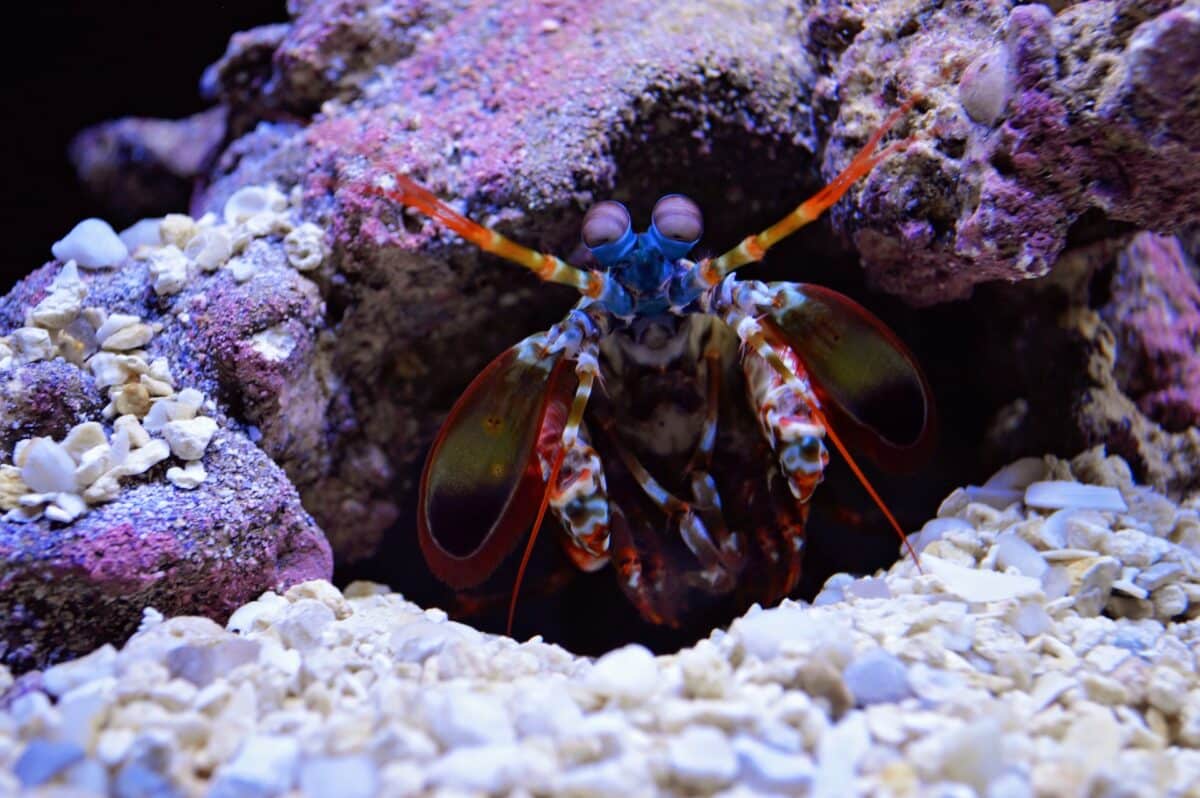
The critically endangered Alabama cave shrimp represents one of North America’s most specialized adaptations to subterranean darkness and underscores the vulnerability of such highly adapted species. Found only in a handful of underground pools within specific cave systems in northern Alabama, these translucent crustaceans have evolved over millions of years to thrive in perpetual darkness. They display the classic traits of troglomorphism—adaptations to cave life—including the complete absence of eyes, loss of pigmentation resulting in their ghostly appearance, and elongated antennae that serve as their primary sensory organs. These specialized appendages are covered with chemoreceptors and mechanoreceptors that can detect minute chemical changes in the water and the slightest movements of potential prey or predators. Their metabolism has slowed dramatically compared to surface-dwelling relatives, allowing them to survive in an environment where food sources are scarce and unpredictable. What makes these shrimp particularly remarkable is their extreme longevity—they can live up to 10 years, significantly longer than related surface species, and take much longer to reach sexual maturity. They feed primarily on organic matter that washes into the caves during flooding events and on bacterial films that grow on cave surfaces. Their extreme specialization, however, has made them exceptionally vulnerable to habitat alteration, with groundwater pollution and changes in water flow patterns from urban development threatening their existence.
Conclusion: The Remarkable Adaptability of Life in Darkness

The 13 species we’ve explored represent some of nature’s most extraordinary examples of evolutionary adaptation to one of life’s most fundamental challenges—surviving without light. From the cave-dwelling olm that can live for a century to bacteria creating entire ecosystems based on chemical energy, these organisms demonstrate that life can not only persist but thrive in what we might consider impossible conditions. Their
- 12 Fascinating Shark Facts And 3 That Are Totally Wrong - August 21, 2025
- 11 Animals That Can Clone Themselves - August 21, 2025
- 15 Cat Breeds Vets Secretly Wish You’d Stop Buying - August 21, 2025

